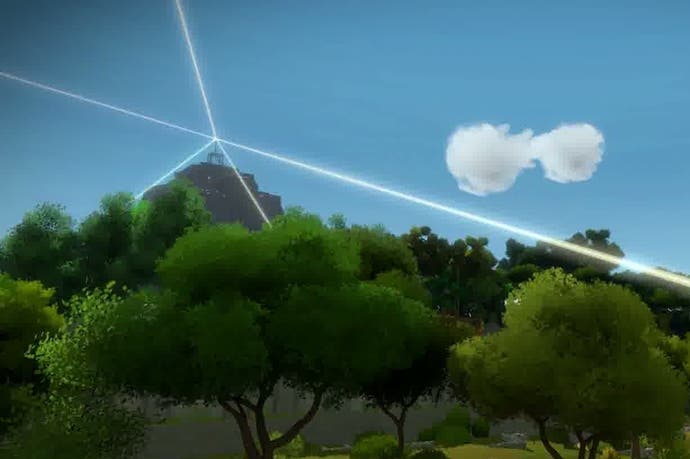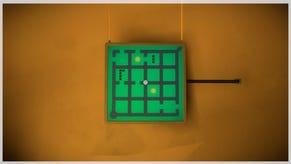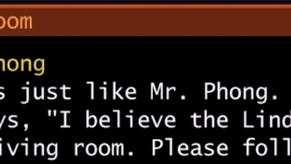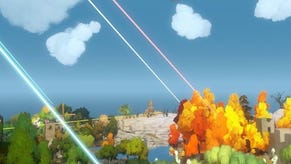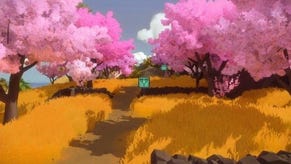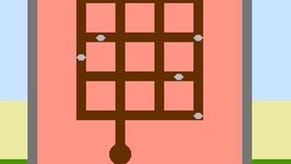Witness The Witness
Jonathan Blow explains why his PS4 puzzle adventure doesn't need explaining.
There are a couple of refreshing things about Braid designer Jonathan Blow's presentation of his next game The Witness on Sony's stand at E3. The first is that it's happening at all. The second is that he's showing us the actual game. Such is the illusory nature of the great annual video game circus, where even virtual worlds aren't real.
To tackle the first: whilst it's not all that rare to find an abstract and intellectually challenging indie game like The Witness at E3, it is rare for a platform holder to be dedicating hour-long slots in its media theatre to presenting it. Doubly so when you consider that Sony isn't even publishing The Witness, like it did thatgamecompany's Journey; Blow is self-publishing the game. Regardless, he's been selected as the poster child for indie gaming on PS4, having presented The Witness at the console's unveiling in New York in February. It will debut exclusively on PS4 (though it will most likely appear on other platforms, like Steam, later).
Blow is impressed by Sony's commitment to indie games: "Right downstairs, there's just a ton of them," he says, gesturing towards the door and Sony's vast presence on the show floor. "It's easy to go, 'Hey, we like indies,' but E3 floor space is not cheap." However, anxious not to present himself as a Sony spokesperson, he doesn't presume to explain what's behind it. That motivation is not that hard to read, though, especially in an experienced media distributor like Sony. Its film and music divisions wouldn't be seen dead without signings like Michael Haneke's Amour or Jack White's Blunderbuss; why should its games platform be any less rounded? Viewed from that angle, it's crazy that this hasn't happened sooner.
What happens next is arguably more brave and unusual. Blow simply loads up the latest build of the game, which he pulled from his servers two days previously. It is not a vertical slice, not a demo version, and this is not a rehearsed presentation either. It's the entirety of The Witness as it currently exists. It has bugs and unfinished art, which Blow seems perversely proud to show off. At one point it crashes. Blow uses debug controls to skip puzzles and fly us freely around the game's setting, a mysterious, open-world island. This is the actual game, in development, incomplete yet whole. "I'm keeping it real, I guess," he says. It's a little sad to reflect afterwards on how thrilling a thing that is to see at E3.
Blow talks constantly as he plays, expressing himself with fluid precision as he explains exactly what his bizarre game design is trying to achieve at any moment. When he answers a question, it's in a stream of thoughts that flows from one to the next without definitively ending - it just peters out, abruptly, a few moments after he realises he's already made his point.
The Witness is very recognisable as the game Chris Donlan encountered in a hotel room almost two years ago. (That press tour was the first time anyone outside Blow's 14-man team played the game, he tells us at E3; he would leave journalists alone to explore it for a couple of hours, then come back and discuss their experience, cheekily rolling playtesting and PR into one.) It initially appears to be a game within a game. It presents puzzles on panels that involve you drawing a line through a maze, from a start point to the exit, whilst obeying certain rules; join the dots, separate white areas from black, and so on. Sometimes these panels appear in sequences, visibly developing an idea from one to the next, turning simple forms into complex ones; tutoring the player.
It seems like a neat, abstract little DS or iPhone puzzle game that for some reason has been embedded in a first-person adventure. The puzzle panels are dotted about an island which is thick with pretty, autumnal groves of trees, ruined buildings and strange technologies, but appears devoid of human or animal life. You're free to explore this space, which Blow says contains around 30 hours of gameplay. It's much more visually inviting than when Chris saw it. Lush, pastel vegetation contrasts with broken, bleached stone. It has an otherworldly atmosphere of pastoral abandon that many will compare with Myst, but reminded me most of the recent lo-fi experiment Proteus. Blow says this atmosphere will be reinforced with a rich soundscape, but no music, in the final game.
"I'm taking the structure of a classical adventure game, but getting rid of all the things that are terrible about adventure games" - Jonathan Blow
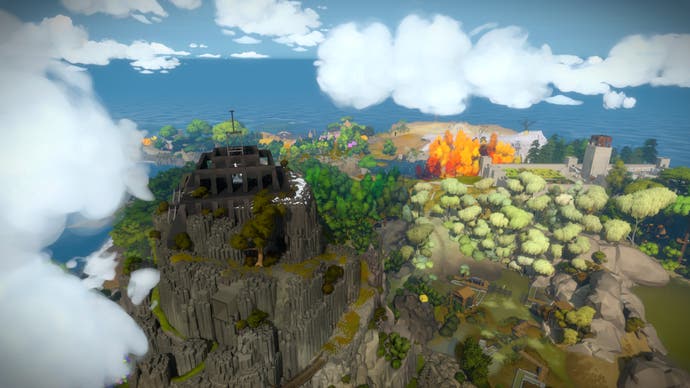
The contrast between the completely abstract puzzle gameplay and exploration of this pocket universe bothers me, to begin with. Simply connecting a puzzle panel to a door by a power cable seems a rather blunt and arbitrary way to link the two halves of The Witness. But of course, Blow has bigger ideas, and the puzzles gradually start to spill out of the panels. Sometimes you'll need to spot clues in the environment, like an apple hanging from a tree. Sometimes you'll need to physically line a puzzle up to see its solution, viewing it through a woodcut for example. On one occasion, drawing around the base of a bonsai tree growing out of a panel is used to change the configuration of the building we're standing in.
"I'm taking the structure of a classical adventure game, but getting rid of all the things that are terrible about adventure games," says Blow matter-of-factly. Inventories, parsing and hunting for objects or interactive spots are out. So is any kind of verbal communication whatsoever. Aside from a button prompt instructing you to interact with the very first puzzle panel, there is no tutorialisation in The Witness at all. The game is "all about non-verbal communication", says Blow (although it will also contain audio logs that tell a story about the island and ultimately explain why you're on it and who, or what, you are).
As he talks us, with patient thoroughness, through the techniques he's using to lead and expand players' understanding through each sequence of puzzles using only the puzzles themselves, it becomes clear that Blow is deeply preoccupied - not to say obsessed - with the idea of using his line-drawing puzzles as a language of their own. "It's not an arbitrary collection of puzzles. It's a stream of ideas being communicated," he says. The current version of the game has 500 panels in it. He estimates that he's made somewhere between 800 and 900.
Blow wants players to experience a constant sense of broadening understanding as they play, but not necessarily a constant increase in difficulty. "I think we can make games interesting in more ways than just challenge," he says. "We can make them interesting through what happens." Easy puzzles that communicate ideas quickly will be alternated with obtuse ones that are solved with satisfying 'eureka' moments. He shows us how knitting together a long, semi-linear sequence of puzzles eventually brings one of seven laser turrets online. This points the way to a large structure which contains the "really hard" endgame.
"There are a lot of psychological studies that say explicit rewards demotivate you from the rest of the game. As a game designer, I'm very careful about that." - Jonathan Blow
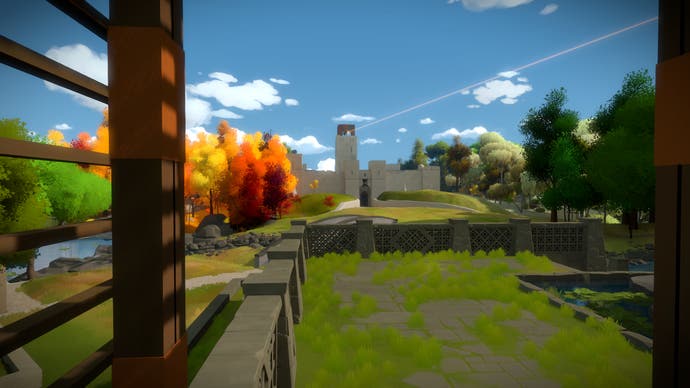
But Blow is wary of imposing any kind of traditional reward structure on The Witness. "There are a lot of psychological studies that say explicit rewards demotivate you from the rest of the game," he says. "If you have a game that's about getting loot, and you're fighting monsters to get loot, you end up not necessarily being interested in fighting monsters for its own sake, you just want loot. As a game designer, I'm very careful about that. With this game I'm trying to do a lot of things about communication, and about having these moments of epiphany, understanding the world you're in."
The Witness's intellectual rigour - its pursuit of enlightenment through puzzle gameplay and nothing else - is impressive. But it's not ground-breaking. Games have been explaining themselves through mechanics and visual cues rather than tutorial popups for decades - the good ones have, anyway. Some of Blow's work here appears to be more dogged and disciplined than inspired, as he breaks down and then painstakingly reconstructs all the implications and permutations of the puzzle systems he's come up with.
But in being so thorough about it, it does feel like Blow is reverse-engineering the concept of game design itself, recreating it in its purest form. Beyond that, in the expanding relationship between the abstract puzzles and the world around them, he's created an arena where a leap of imagination will bring you to the solution, rather than the maze of logic gates that Blow has so carefully set up for you.
It's in the synthesis of these two - and the gradual unfolding of the secret history of the island - that The Witness has the potential to become more than just an interesting thought experiment by one of the world's brainiest game designers. Its charms will remain very theoretical while that synthesis remains unproven. It's something that couldn't be demonstrated in one hour amid the lobotomised chaos of E3, anyway - but all due respect to Jonathan Blow and to Sony for trying.
